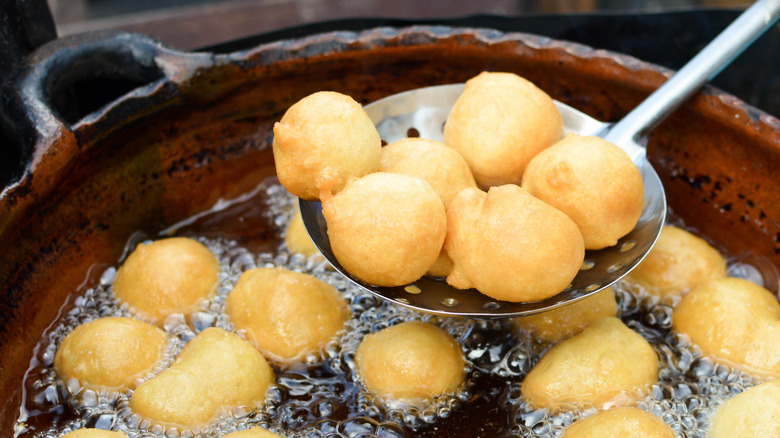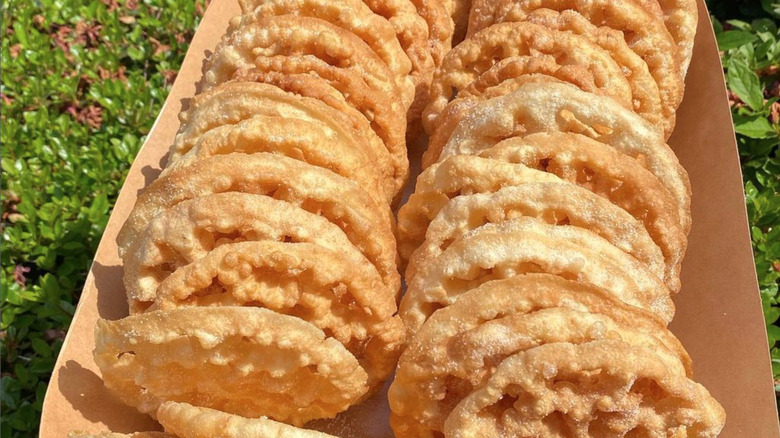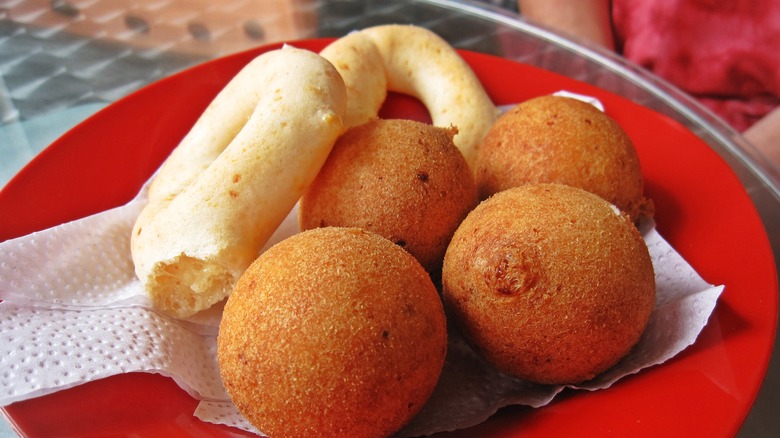What Makes Mexican Buñuelos Unique?
Christmas comes but once a year, but in Mexico, it lasts over three weeks — from December 12 to January 6. On Christmas Eve, called Noche Buena, the main meal is served, with dishes like pozole (soup with hominy, chilies, and meat ), turkey, tamales, and romeritos (vegetables cooked in mole sauce with shrimp and potatoes.) per Why Christmas.
Like many countries, desserts play an important role in holiday celebrations and then lead us to make ambitious diet goals for the new year! Sweets like chocolate almond babka in Poland, pavlova (meringue) in Australia, and pfeffernusse cookies in Germany — to name just a few — are traditions kids and adults look forward to each year. But in Mexico, and probably most countries in Latin America, buñuelos continue to be the star of the show. Don't be fooled by their simple appearance, as these treats are an absolute culinary delight.
The origins
Like decorated cookies in America, buñuelos are a traditional Christmas dessert in Latin America, made from fried dough and dusted with sugar or topped with syrup. Despite popular belief, buñuelos did not originate in Mexico but instead had their roots in Spain while under Muslim rule (per NY Times). The Spaniards, who colonized Latin America, brought them over and, according to The New York Times, made buñuelos using different local ingredients, depending on their region. For example, in Cuba and Nicaragua, these pastries were made out of yuca and other root vegetables.
The name buñuelo is from the Spanish word "puño," meaning fist, and the story goes that sometime in the 11th century, because oven fuels were scarce, a Moorish baker found a cheaper way to make bread by tossing dough into boiling oil, and thus buñuelos were created (via WUSF News).
Buñuelos, Mexican style
Mexican buñuelos are made from dough that is rolled out until thin and then deep fried, in contrast to other Latin American versions, which tend to be thick and puffy and closely resemble donuts (per NY Times). Light and crispy, Mexican buñuelos use less yeast than other pastries — like sopapillas which are heavy in fat and eggs — and, as a result, are flat and crispy, closely resembling fried flour tortillas (via Muy Bueno Cookbook). Traditionally these buñuelos are topped off with piloncillo — a syrup made from a cone of raw sugar (commonly found in Mexican grocery stores), which, according to House of Yumm, has the consistency of molasses and has a burnt, caramel flavor. The taste is both bitter and sweet. Piloncillo syrup is made by crushing the sugar, and after boiling and pouring it into molds to harden, it can be made into different festive shapes (per House of Yumm).
There are many varieties of Mexican buñuelos, often from different areas of the country. In the province of Veracruz, for example, sweet potato and pumpkin buñuelos fried in lard and topped with sugar are a popular dish, and in Tlacotalpa, you can find rice buñuelos, in which ground cooked rice is mixed with anise seed tea to give it a distinctive flavor (via Mexico In My Kitchen).
Delicious and diverse
Since the buñuelos were brought from Spain to the new world, most countries in Latin America have their own unique version of these little treats. Colombian buñeulos have a mix of melted soft cheeses inside that are enjoyed for breakfast (per Mitú). The Colombian people deeply cherish these little crispy balls in their daily lives and also while celebrating the holidays (per WLRN). Buñuelos are also popular in the Carribean islands, like Puerto Rico, where they tend to be savory versus the sweeter versions we see in Mexico. Buñuelos come in many different shapes and flavors and allow for some creativity and cultural expression. Nowadays, you can even find vegan or paleo buñuelos adding to the large world it already reaches.
We all look forward to Christmas food, especially the sweet kind, and Mexican or other types of buñuelos should top the list — but not just on holidays!



